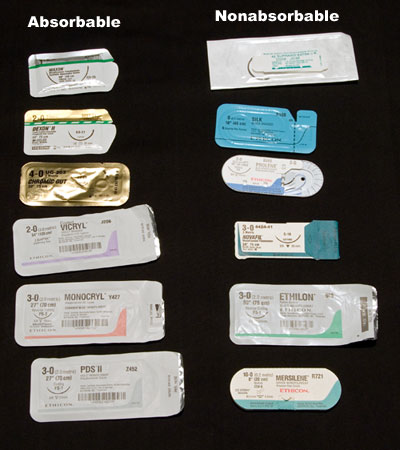Absorbable or nonabsorbable suture material?
Considerations:
- tissue being sutured?
- how long to regain sufficient wound strength so that suture support is no longer needed?
- exclude suture materials losing significant tensile strength before the tissues will regain sufficient wound strength
- any patient factors that may delay healing? (eg. concurrent disease, primary disease, specific procedure)
- any consequences if suture material persists? (e.g. nonabsorbable suture in bladder lumen avoided as can serve as a nidus for calculi formation)
- absorbable suture maintaining sufficient tensile strength for anticipated duration of healing selected when available
- if necessary to bury a nonabsorbable suture, choose a monofilament suture as associated with less complications.
Monofilament or multifilament material?
Considerations:
- Is this a contaminated procedure?
- What is the potential for infection?
Multifilament nonabsorbable materials should NOT be used if the surgical site is infected or contaminated.
- if site is infected, leave as open wound if possible
- if the site must be sutured, select an absorbable material and minimize number of sutures placed
- if prolonged support is necessary (beyond that provided by the slowly absorbable materials), monofilament nonabsorbable sutures can be used with infrequent complications
Monofilament sutures are recommended for skin to prevent wicking surface bacteria to deeper tissues and give the best cosmetic results.
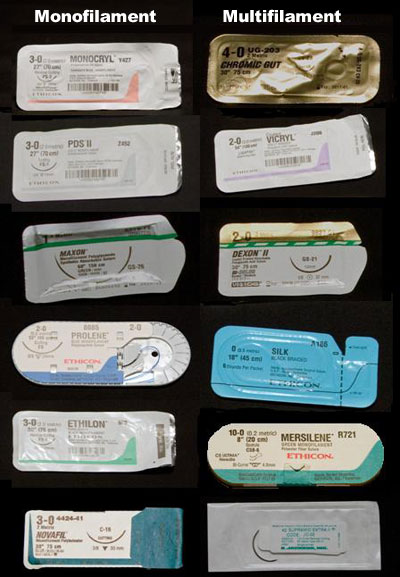
Any specific requirements for the procedure being performed?
How much tissue reaction is acceptable?
- most synthetic suture materials are minimally reactive
- Polypropylene is the least reactive material and a good choice when minimal reaction is critical for success
- is a really strong suture required?
- strongest suture materials are the braided polyesters
- desired strength must be weighed against suture’s potential to harbor bacteria and form chronic draining tracts
- what is the material’s knot security and how critical is this?
- are additional throws necessary?
- will a bulky knot (lots of throws) cause any problems?
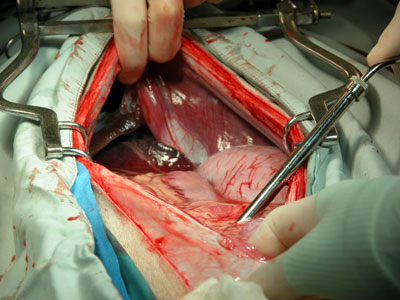
What size of suture material is needed to support this wound?
- What is the strength and supporting function of tissue being sutured?
- tensile strength of suture should approximate tissue being sutured
- veterinarians tend to select excessively large suture sizes
- Any special patient factors to consider? (eg.“exuberant” patient, inability of owner to restrict activity, concurrent disease delaying healing)
- when closing linea alba/rectus fascia with a simple continuous pattern, recommended to select one size larger than would for interrupted pattern
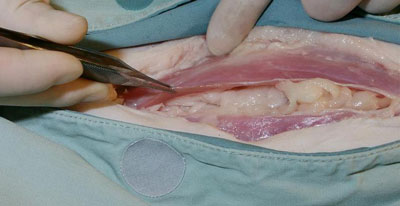
What needle is needed?
- What size, shape and point of needle is needed and does it come with the selected suture material and size?
- What size of needle will reach across both sides of the incision at the desired depth?
- How tough or fragile is the material being closed (ie. taper, taper cut, or cutting)?
- Reverse cutting needles are generally preferred for skin
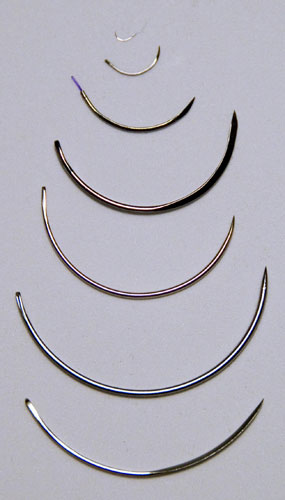
What is your personal preference?
From your list of suitable sutures, choose your final selection based on:
- your own preference (what do you like to work with?)
- economics (which is the cheapest?)
- availability (what do you have on your shelf?)
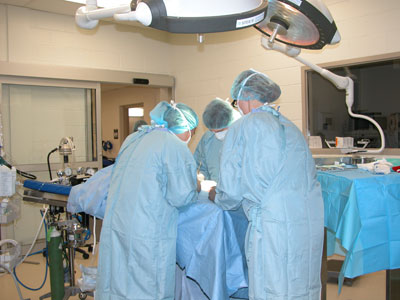
General Guidelines
Table 3: Guidelines for suture material selection
|
Tissue
|
Small dog or cat
|
Large dog
|
Horse
|
Cow
|
| Skin |
4-0 nonabsorbable monofilament
|
3-0 nonabsorbable monofilament
|
2-0 to 3-0 nonabsorbable
monofilament |
#1 to #2 nonabsorbable
|
| Subcuticular |
3-0 to 4-0 absorbable
|
3-0 absorbable
|
3-0 absorbable
|
N/A
|
| Subcutaneous |
3-0 to 4-0 absorbable
|
2-0 to 3-0 absorbable
|
2-0 to 3-0 absorbable
|
2-0 to 0 absorbable
|
| Fascia (light) |
3-0 to 4-0 absorbable
|
2-0 to 3-0 absorbable
|
0 to #1 absorbable
|
#1 to #2 absorbable
|
| Fascia (heavy abdominal wall) |
2-0 to 3-0 slowly absorbable monofilament
|
0 to 2-0 slowly absorbable monofilament
|
#2 to #7 slowly absorbable monofilament
|
#1 to #2 slowly absorbable monofilament
|
| Muscle |
2-0 to 3-0 absorbable
|
0 to 2-0 absorbable |
0 to #1 absorbable
|
1 to #2 absorbable
|
| Tendon |
0 to 3-0 slowly absorbable or nonabsorbable
|
1 to 2-0 slowly absorbable or nonabsorbable
|
#1 to #3 slowly absorbable or nonabsorbable
|
#1 to #3 slowly absorbable or nonabsorbable
|
| Viscera |
4-0 absorbable
|
3-0 to 4-0 absorbable
|
2-0 to 3-0 absorbable
|
2-0 to 3-0 absorbable
|
| Small vessels |
3-0 to 4-0 absorbable
|
2-0 to 4-0 absorbable
|
2-0 to 3-0 absorbable
|
2-0 to 3-0 absorbable
|
| Large vessels |
2-0 to 3-0 absorbable
|
0 to 2-0 absorbable
|
0 to 2-0 absorbable
|
0 to 2-0 absorbable
|


